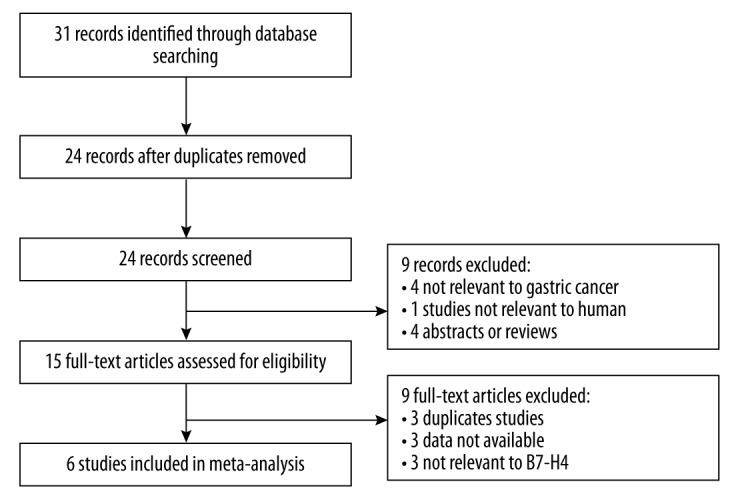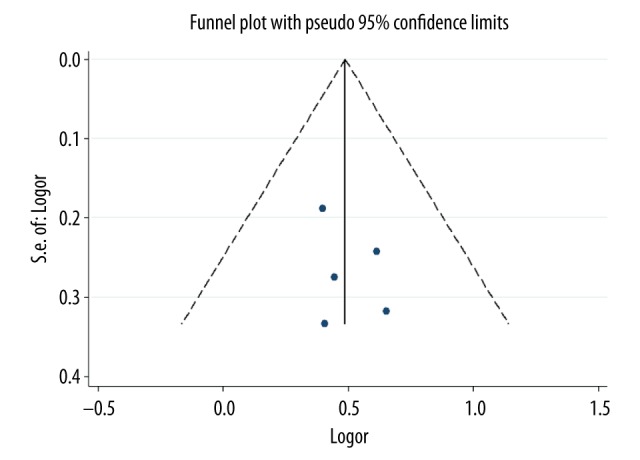Abstract
Background
Recently, some studies were performed to evaluate the relevance of B7-H4 and gastric cancer (GC) prognosis. However, the results remained controversial. Therefore, we performed the present meta-analysis.
Material/Methods
We performed a systematic search in PubMed and Web of Science databases. All data were extracted and reviewed from each eligible study independently by 2 investigators. The strength of association between B7-H4 and GC prognosis was assessed by computing odds ratio (OR) with its corresponding 95% confidence interval (CI).
Results
Six studies that evaluated the association between B7-H4 and GC prognosis were included. The results showed a statistically significant association of B7-H4 and GC prognosis (OR=1.63, 95%CI=1.30–2.03). Furthermore, we conducted subgroup analysis based on source of B7-H4; the results from blood (OR=1.71; 95%CI, 1.09–2.68) and tissue (OR=1.60; 95%CI, 1.03–2.07) indicated B7-H4 was significantly associated with poor prognosis.
Conclusions
This meta-analysis suggests that GC patients with high B7-H4 have poor prognosis.
MeSH Keywords: Prognosis, Stomach Neoplasms, V-Set Domain-Containing T-Cell Activation Inhibitor 1
Background
Gastric cancer (GC) is one of the most common cancers world-wide [1]. In males and females it is the third and fifth, respectively, most common cause of cancer-related deaths [2]. The mechanisms of GC development are still not clear. Thus, it is very important to find biomarkers of GC.
B7-H4 is a novel protein, which is a member of the B7-CD28 family. It is detected in many cancers, such as lung, breast, and brain cancers as well as GC [3]. Sica et al. found that B7-H4 ligation of T cells can inhibit the growth, cytokine secretion, and development of cytotoxicity [4]. Choi et al. reported a critical role of B7-H4 in tumor immunity [5]. Therefore, there might be an association between B7-H4 and GC prognosis. Recently, some studies were performed to evaluate the relevance of B7-H4 and GC prognosis [6–11]; therefore, we performed the present meta-analysis.
Material and Methods
Publication search
We performed a systematic search in PubMed and Web of Science databases (update until October 2015) for all English-language publications, using combinations of the following key words: “B7-H4” and “Gastric cancer or Gastric carcinoma”. In order to obtain as many eligible studies as possible, we also examined all relevant references in the selected publications. Review articles, meeting abstracts, and animal experiment studies were not considered.
Inclusion and exclusion criteria
Inclusion criteria were: (a) estimation the association between B7-H4 and GC prognosis and (b) sufficient original data for calculating an odds ratio (OR) with its 95% confidence interval (CI).
Data extraction
All data were extracted and reviewed from each eligible study independently by 2 investigators, and any potential conflict was resolved by discussion between the 2 reviewers. The following data were extracted: the first author’s name, year of publication, country, sample size, source of B7-H4 (blood or tissue), and adjustment.
Quality assessment
Quality assessment was performed according to Strengthening the Reporting of Genetic Association studies (STREGA) [12]. STREGA contains 11 items. For each item, there are 3 degrees, “yes” (scored 2) “can’t tell” (scored 1), and “no” (scored 0). Studies were divided into 3 grades. Only Grade A and B studies were included.
Statistical analysis
The strength of association between B7-H4 and GC prognosis was assessed by computing odds ratio (OR) with its corresponding 95% confidence interval (CI). The statistical significance of pooled ORs was also calculated by the Z-test (P<0.05 shows the association was statistically significant). The heterogeneity among eligible studies was checked by the chi-square – based Q test. When the P<0.05 indicated statistical heterogeneity to be significant among studies, the random-effects model (Der-Simonian and Laird method) was used to analyze the pooled ORs. Otherwise, the fixed-effects model (Mantel-Haenszel method) was used if the P-value was >0.05. We conducted a sensitivity analysis to evaluate the stability of the results by removing each individual study 1 at a time. Finally, Egger’s linear regression test and Begg’s funnel plot analysis was used to weight the potential publication bias. All the P-values were 2-sided. All statistical analyses were carried out using STATA software (version 11.0; Stata Corporation, College Station, TX).
Results
Study characteristics
In total, 31 articles were obtained initially through PubMed and Web of Science electronic databases. After screening by title, abstract, and full text, 6 studies that evaluated the association between B7-H4 and GC prognosis were included. Two studies were from Japan and 4 were from China. B7-H4 was detected in blood in 2 studies. The flow diagram for searching and selecting articles is illustrated in Figure 1. Characteristics of studies are displayed in Table 1.
Figure 1.

Flow of study selection.
Table 1.
Characteristics of the studies.
| First author | Country | Included patients | B7-H4 source | Quality grade | Adjusted |
|---|---|---|---|---|---|
| Arigami (2010) | Japan | 94 | Blood | A (scored 21) | Yes |
| Jiang (2010) | China | 156 | Tissue | A (scored 20) | Yes |
| Arigami (2011) | Japan | 120 | Tissue | A (scored 18) | Yes |
| Geng (2014) | China | 100 | Tissue | A (scored 19) | Yes |
| Maskey (2014) | China | 102 | Tissue | A (scored 17) | No |
| Shi (2014) | China | 132 | Blood | A (scored 19) | Yes |
Results of the meta-analysis
A total of 602 GC patients were included in the 6 selected studies focused on evaluating the possible association between B7-H4 and GC prognosis. The results showed a statistically significant association of B7-H4 and GC prognosis (OR=1.63, 95%CI=1.30–2.03) (Figure 2). We conducted subgroup analysis based on source of B7-H4. The results from blood (OR=1.71; 95%CI, 1.09–2.68) and tissue (OR=1.60; 95%CI, 1.03–2.07) indicated B7-H4 was significantly associated with poor prognosis. To assess the robustness and reliability of the association results, we performed sensitivity analyses by repeatedly removing each individual study. The results indicated that no substantial changes were observed, suggesting the overall analysis results of this meta-analysis were reliable and convincing (Figure 3). Begg’s funnel plot and Egger’s test were used to assess the potential publication bias of articles. Asymmetrical funnel plots were not observed and the result of Egger’s test also indicated no publication bias (P=0.1; Figure 4).
Figure 2.

Meta-analysis for the association between B7-H4 and prognosis of GC.
Figure 3.

Sensitivity analysis for the association between B7-H4 and prognosis of GC.
Figure 4.

Funnel plot of the association between B7-H4 and prognosis of GC.
Discussion
To the best of our knowledge, this is the first meta-analysis conducted to evaluate the association between B7-H4 and GC prognosis. In this study, we observed a significant association between high B7-H4 level and poor GC prognosis. We then conducted subgroup analysis to further investigate the effect of source of B7-H4. In the subgroup analysis, significant associations were also detected in blood and tissue.
Arigami et al. found that B7-H4 was significantly associated with lymph node metastasis, depth of tumor invasion, and overall stage [6]. Jiang et al. found that B7-H4 expression correlated positively with cancer invasiveness and lymph node metastasis [7]. Geng et al. also indicated that B7-H4 was positively correlated with depth of tumor invasion, lymph node metastasis, and American Joint Committee on Cancer (AJCC) stage [9]. All these data might explain why GC patients with high B7-H4 level showed poor prognosis. Thus, we should pay more attention to the patients with high B7-H4 level.
Liquid biopsy is an important issue in the recent studies. In this study, we found that B7-H4 from blood could indicate a poor prognosis of GC. This result suggests that liquid biopsy could be used to assess GC prognosis. However, there were only 2 studies that investigated the association between blood B7-H4 and GC prognosis. Thus, more studies should be conducted to further confirm this result.
Several limitations of the present study considered. Firstly, we only searched for articles with sufficient original data and published in English; therefore, some bias might have been present in our results, although the funnel plot and Egger’s test showed no obvious publication bias. Secondly, although 6 articles were collected in our meta-analysis, the number of eligible studies was small. Despite these limitations, the study also has some advantages: our study is more reliable than an individual study, and publication bias was not detected in the pooled results.
Conclusions
Our meta-analysis suggests that GC patients with high B7-H4 could have poor prognosis. Further well-designed studies with large sample sizes are needed to confirm our results.
Footnotes
Conflicts of interest
None.
Source of support: Departmental sources
References
- 1.Soerjomataram I, Lortet-Tieulent J, Parkin DM, et al. Global burden of cancer in 2008: A systematic analysis of disability-adjusted life-years in 12 world regions. Lancet. 2012;380(9856):1840–50. doi: 10.1016/S0140-6736(12)60919-2. [DOI] [PubMed] [Google Scholar]
- 2.Jemal A, Bray F, Center MM, et al. Global cancer statistics. Cancer J Clin. 2011;61(2):69–90. doi: 10.3322/caac.20107. [DOI] [PubMed] [Google Scholar]
- 3.Qian Y, Hong B, Shen L, et al. B7-H4 enhances oncogenicity and inhibits apoptosis in pancreatic cancer cells. Cell Tissue Res. 2013;353(1):139–51. doi: 10.1007/s00441-013-1640-8. [DOI] [PubMed] [Google Scholar]
- 4.Sica GL, Choi IH, Zhu G, et al. B7-H4, a molecule of the B7 family, negatively regulates T cell immunity. Immunity. 2003;18(6):849–61. doi: 10.1016/s1074-7613(03)00152-3. [DOI] [PubMed] [Google Scholar]
- 5.Choi IH, Zhu G, Sica GL, et al. Genomic organization and expression analysis of B7-H4, an immune inhibitory molecule of the B7 family. J Immunol. 2003;171(9):4650–54. doi: 10.4049/jimmunol.171.9.4650. [DOI] [PubMed] [Google Scholar]
- 6.Arigami T, Uenosono Y, Hirata M, et al. Expression of B7-H4 in blood of patients with gastric cancer predicts tumor progression and prognosis. J Surg Oncol. 2010;102(7):748–52. doi: 10.1002/jso.21722. [DOI] [PubMed] [Google Scholar]
- 7.Jiang J, Zhu Y, Wu C, et al. Tumor expression of B7-H4 predicts poor survival of patients suffering from gastric cancer. Cancer Immunol Immunother. 2010;59(11):1707–14. doi: 10.1007/s00262-010-0900-7. [DOI] [PMC free article] [PubMed] [Google Scholar]
- 8.Arigami T, Uenosono Y, Ishigami S, et al. Clinical significance of the B7-H4 coregulatory molecule as a novel prognostic marker in gastric cancer. World J Surg. 2011;35(9):2051–57. doi: 10.1007/s00268-011-1186-4. [DOI] [PubMed] [Google Scholar]
- 9.Geng Y, Wang H, Lu C, et al. Expression of costimulatory molecules B7-H1, B7-H4 and Foxp3+ Tregs in gastric cancer and its clinical significance. Int J Clin Oncol. 2015;20(2):273–81. doi: 10.1007/s10147-014-0701-7. [DOI] [PubMed] [Google Scholar]
- 10.Maskey N, Li K, Hu M, et al. Impact of neoadjuvant chemotherapy on lymphocytes and co-inhibitory B7-H4 molecule in gastric cancer: Low B7-H4 expression associates with favorable prognosis. Tumour Biol. 2014;35(12):11837–43. doi: 10.1007/s13277-014-2410-2. [DOI] [PubMed] [Google Scholar]
- 11.Shi H, Ji M, Wu J, et al. Serum B7-H4 expression is a significant prognostic indicator for patients with gastric cancer. World J Surg Oncol. 2014;12:188. doi: 10.1186/1477-7819-12-188. [DOI] [PMC free article] [PubMed] [Google Scholar]
- 12.Little J, Bradley L, Bray MS, et al. Reporting, appraising, and integrating data on genotype prevalence and gene-disease associations. Am J Epidemiol. 2002;156(4):300–10. doi: 10.1093/oxfordjournals.aje.a000179. [DOI] [PubMed] [Google Scholar]
- 13.Lv J, Lv CQ, Xu L, Yang H. Plasma content variation and correlation of plasmalogen and GIS, TC, and TPL in gastric carcinoma patients: A comparative study. Med Sci Monit Basic Res. 2015;21:157–60. doi: 10.12659/MSMBR.893908. [DOI] [PMC free article] [PubMed] [Google Scholar]
- 14.Wang Q, Xue Y. Characterization of solid tumors induced by polycyclic aromatic hydrocarbons in mice. Med Sci Monit Basic Res. 2015;21:81–85. doi: 10.12659/MSMBR.893945. [DOI] [PMC free article] [PubMed] [Google Scholar]
- 15.Pergolini I, Crippa S, Santinelli A, Marmorale C. Skeletal muscle metastases as initial presentation of gastric carcinoma. Am J Case Rep. 2014;15:580–83. doi: 10.12659/AJCR.891397. [DOI] [PMC free article] [PubMed] [Google Scholar]


